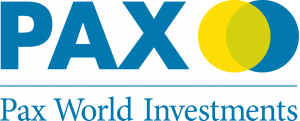 If you’re an investor, putting capital to work in companies where there is a large number of women in management pays off. In fact, year-to-date, many of the bigger gender-lens investing funds have surpassed the performance of the S&P 500 index. Pax World uses the
If you’re an investor, putting capital to work in companies where there is a large number of women in management pays off. In fact, year-to-date, many of the bigger gender-lens investing funds have surpassed the performance of the S&P 500 index. Pax World uses the
MSCI World Index as its benchmark due to its global exposure.
On Wednesday, March 15, RIA Channel hosted the Invest4Impact Symposium for over 2,000 financial advisors. The event covered investing opportunities in everything from women run businesses, to the next big commodity: water. But it was women that kicked off the show, starring one of the market’s biggest woman’s strategy investors, Kathleen McQuiggan, senior vice president at Pax World Management.
What is gender lens investing?
Gender-lens investing has been defined by the markets over the last few years as a process of integrated gender into the investment analysis. Why bother bringing this idea into your investment portfolios? It’s not because of some political slogans like “the future is female”. It’s two-fold, really. It’s demographics: more women worldwide making more money and gaining traction in corporate America. And it’s the right thing to do: making the workplace more acceptable to give power to women.
Currently, in the American corporate pipeline as of 2016, women were 46% of entry level and collapsed to 19% of those in the C-suite, according to a Mckinsey and Company report titled “Women in the Workplace,” published last year with LeanIn.org.
Only 7% of women surveyed by Ernst & Young believe that the reason is a shortage of female candidates. So, more can be done. And when it is done, funds like Pax World invest. They have no problem finding buyers.
Growing Interest and Investment Options
By the mid-half of last year, some $561 million was invested in so-called Gender Lens Investing (GLI 0,13 +0,02 +13,04%) funds with the biggest one being State Street Global Advisors with $280 million. Pax came in second place with $97 million.
The Pax Ellevate Global Women’s Index Fund (PXWIX 31,66 -0,01 -0,03%), ranked three stars by Morningstar, invests in developed-markets stocks, including those of the United States. It counts Microsoft (3 women on board of 12), Nike (3 of 12), Johnson & Johnson (2 of 9) and Facebook (2 of 8) as its top four holdings. Year-to-date, it’s beat out the S&P 500, rising by 6.7% as of March 15. Over the longer haul, however, it has not held up as well.
But for those who believe putting money to good work is as important as capital gains on that money, the lower upside is tolerable. That fund is up nearly 10% in the last 10 years. No one expects that an entire portfolio is going to be invested in GLI, but as a diversified part of a larger investment strategy, these funds have been money makers just like the broader equity indexes.
The Barclays Women in Leadership Fund (WIL 86,93 0,00 0,00%) is another good one. It rose 21.9% in 10 years and has beat the S&P over the last 12 months by about 100 basis points, rising 17.9%.
“Just focusing on this concept of investing in women, women today are becoming a viable economic force,” says McQuiggan. “In the next five years, the global income of women will grow from 13 trillion to 18 trillion,” she says, noting the importance of women in academia, and in the sciences.
McKinsey estimates that $12 trillion will be added to global GDP by 2025 via gender equality, with two-thirds of millionaires in the U.S. expected to be women within a generation. High net worth women are looking to use their wealth not only for financial independence, but to use their money to make an impact on the world. That includes investing in companies that they deem match their social values when it comes to women in the workplace. This type of fund has been popular among green-thinking investors. The same came be done for gender themed investors.
“This is where we think there is an opportunity for financial advisors in bringing a gender lens to your portfolio,” McQuiggan says about the economic data.
The Activist Investor
Pax fund managers vote with their money. They promote women at the board level, among other initiatives, in proxy votes for shareholders. Investors who share those views might want to get in on funds with the same values, even if they are not always beating the market.
Recent research by Credit Suisse, RobecoSAM, and Morgan Stanley has shown that companies with more women in management and on boards, as well as those with better gender diversity reflected throughout their businesses, do tend to outperform companies with fewer women in management and with lower gender diversity.
A March 2 Morningstar report by Jon Hale, head of sustainability research, tried making the case for corporate governance, particular those companies that have more women in leadership roles. Hale hints that activist investors that put money to work in companies that have more women in positions of power are speaking up for gender issues, namely those important to women in the workplace. Beyond that, however, companies that tend to have an equal balance of power at the top do better than those that are dominated by men.
In a few short years, GLI has moved from promising concept to potentially one of the next big things in impact and sustainable investing. Given today’s political climate, this type of financial product could discover new audiences.
“GLI is taking off,” writes Luisamaria Ruiz Carlile and Alison Pyott of Veris Wealth Partners in New York. “More investing solutions will emerge as momentum grows for investing for gender parity,” the Veris partners wrote in a second quarter report last year about the top funds in this space.
From the Veris point of view, a more holistic view of the benefits of women in management at the corporate level will bring more investors into the space.
As women are starting to earn more in the U.S., and awareness of women in the workplace expands in the general zeitgeist of the nation, a number of funds picking companies based on GLI criteria will see increasing inflows from investors…from both genders.

